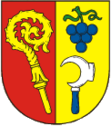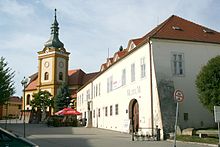Šlapanice
| Šlapanice | ||||
|---|---|---|---|---|
|
||||
| Basic data | ||||
| State : |
|
|||
| Region : | Jihomoravský kraj | |||
| District : | Brno-venkov | |||
| Area : | 1464 ha | |||
| Geographic location : | 49 ° 10 ' N , 16 ° 44' E | |||
| Height: | 230 m nm | |||
| Residents : | 7,563 (Jan 1, 2019) | |||
| Postal code : | 664 51 | |||
| traffic | ||||
| Street: | D 1 : Brno - Vyškov | |||
| Railway connection: | Brno – Vlárský průsmyk | |||
| Next international airport : | Brno-Tuřany | |||
| structure | ||||
| Status: | city | |||
| Districts: | 2 | |||
| administration | ||||
| Mayor : | Jaroslav Klaška (as of 2007) | |||
| Address: | Masarykovo náměstí 7 664 51 Šlapanice |
|||
| Municipality number: | 583952 | |||
| Website : | www2.slapanice.cz | |||
Šlapanice (German Schlapanitz , also Schlappanitz , 1939–45: Lapanz ) is a city in the Czech Republic . It is located nine kilometers east of the city center of Brno on the city limits and belongs to the Okres Brno-venkov .
geography
Šlapanice is located southwest of the Drahaner Bergland on the edge of the Thaya-Schwarza valley basin on the river Říčka ( Goldbach ). Brno Airport is to the southwest of the city , and the battlefield of the Battle of Austerlitz is to the east and southeast . The D 1 motorway runs to the north, on which the exit 203 - Brno-východ with the junction of the expressway 50 to Brno is located in the Bedřichovice district . The Žuráň hill (286 m) rises to the northeast.
Neighboring towns are Bedřichovice in the north, Tvarožná and Kruh in the northeast, Jiříkovice in the east, Ponětovice in the southeast, Kobylnice in the south, Dvorska, Tuřany and Brněnské Ivanovice in the southwest and Slatina in the northwest.
history
Archaeological finds show a Stone Age settlement in the area of the city. There was also a Slavic settlement from the time of the Great Moravian Empire in the 9th century. A Christian tomb dates from the 11th century.
Zlapanicz was first mentioned in a document in 1235 by the Olomouc bishopric in a tithe document for the Oslavany monastery , in which the priest Johannes Plebanus de Zlapanicz was named. In 1241 the place is said to have been burned down by the Tatars . Due to its location on important trade routes, Lapanicz soon gained wealth and received market rights, jurisdiction, including blood jurisdiction, and was promoted to town. Since the transition from the 13th to the 14th century, Šlapanice had a medieval monastery school taught by Olomouc scholastics . The advantageous situation in peacetime also brought devastation and looting by war people passing through. In 1376, Margrave Jobst of Moravia , who lived in Brno, issued a compulsory route to the new trade connections via Brno.
At the beginning of the 15th century the band of robber barons Keyzolt settled in the town, so that the citizens of Brno undertook a punitive expedition against Lapanicz on March 28, 1401. The Brno people stormed the church, which was occupied by the band of robbers, and executed 56 robbers. During the Hussite Wars , a battle took place near Šlapanice on May 17, 1430, in which the Hussites were defeated. In 1449 Ješek von Boskowitz and Svojanov burned the city down on his campaign against the Rajhrad monastery . During the siege of Brno by Matthias Corvinus , the Hungarians plundered and devastated the city several times between 1468 and 1470. The Swedes also invaded Brno during the Thirty Years' War when they besieged Brno twice between 1643 and 1645. In the 17th century the city was divided into three parts - an episcopal rule administered by the Chirlitz (Chrlice) estate, the Unterhof episcopal fief and the Scholasteriegut belonging to the Olomouc Scholastik.
With the Thirty Years' War the city began to decline. Added to this was the growing importance of Brno, which in 1641 had become the capital of Moravia. As a result, Brno developed into the junction of all trade routes in the area and the old trade routes via Šlapanice became deserted. In 1677 and 1733, city fires destroyed parts of the city. On April 6, 1742, Prussian troops devastated the city during the Seven Years' War. In 1757 the entire city was burned to rubble and ashes. During the Second Coalition War , Russian troops under Field Marshal Suvorov were encamped near Schlapanitz around the turn of the year 1798/99 . Before the Battle of Austerlitz , which was fought on the eastern edge of the city, the coalition troops first occupied Schlapanitz in 1805, Marshal Kutusow reached the city on November 18, 1805 and a day later Johann Joseph von Liechtenstein took up quarters in the rectory. A little later the French occupied Schlapanitz and on November 30th, Marshal Soult took up residence in the rectory. During the battle, French hospitals were set up in the scholastery and the former monastery. The church became a camp for 400 Russian prisoners of war by December 3rd. The fallen in the battle were buried in several mass graves in the cemetery.
In 1814 a mechanical engineering workshop was established in the former Paulan monastery, from which the First Brno Machine Factory emerged. The company developed the first Luz steam engine in 1824 . In 1834, 1,072 people lived in the town of 175 houses. After the abolition of patrimonial rule in 1848, the three shares of Schlapanitz were combined into a market town.
In 1871 the peasant share sugar factory was founded, which existed until 1931 and was then converted into a paper factory. With the establishment of the railway over the Wlarapass (Wlara-Bahn) Schlapanitz received a railway connection in 1887. In 1899 an economics school was established. In 1900 Schlapanitz consisted of 472 houses and had 2,918 inhabitants. After the First World War, Šlapanice experienced a strong expansion. In 1931 the Říčka flooded the town. In 1937, a community power station fired with wood gas and crude oil went into operation. In 1939 Šlapanice had 5,125 inhabitants and consisted of 1160 houses. During the time of the Protectorate of Bohemia and Moravia , the city was named Lapanz . 33 residents of the village died in German concentration camps. On April 24, 1945, the Romanian and Red Armies took Lapanz after heavy fighting. Over 75 houses were damaged or destroyed. On January 1, 1965, Šlapanice was raised to the rank of town. In 1975 the river bed of the íčka was regulated. The former economics school was acquired by the Masaryk University in Brno in 1992 and transformed into an educational center.
City structure
The town of Šlapanice consists of the districts Bedřichovice ( Bellowitz ) and Šlapanice ( Schlapanitz ).
Town twinning
- Braine-l'Alleud , Belgium
Attractions
- Church of the Assumption of Mary, the church building documented since 1235, was rebuilt in the 15th century after a fire. Between 1755 and 1757 the church received its current baroque appearance. The 36 m high onion dome was built in 1886 by adding heights to the old church tower.
- Žuráň Hill , with a relief of the course of the Battle of Austerlitz on a granite block . During the battle, Napoleon Bonaparte's headquarters were on the Žuráň .
- Scholasterie and old rectory, the building that was built around 1300 was redesigned in 1613. Before the Battle of Austerlitz, the allied Austro-Russian troops used it as their headquarters and after the battle the IV French Corps under Marshal Soult . Since 1949 it has housed a branch of the Moravian State Museum
- Gymnasium, the Baroque palace built for Heinrich Kajetan von Blümegen in 1750 , served as a Paulan monastery between 1781 and 1784 and as a French military hospital in 1805. From 1814 it served as the factory building of the First Brno Machine Factory. In 1901 it was converted into a school and since 1993 it has housed the grammar school
- Building of the city administration, the building, which has been verifiable as an estate since 1590, was converted in 1877 for Alois Tauschinsky into the seat of the board of directors of the sugar factory in the neo-renaissance style. In 1934 the city museum was established in the building. In 1993 it was converted into the seat of the city administration, and the courtyard wing was created.
- Old town hall, built in the middle of the 16th century, today an inn
sons and daughters of the town
- Alois Kalvoda (1875–1934), painter
- Josef Zeman (1898–1952), priest and sinologist
- Antonín Kalvoda (1907–1974), sculptor
- Antonín Streit (1908–1994), actor
- Libuše Šafránková (* 1953), actress (Three hazelnuts for Cinderella)


